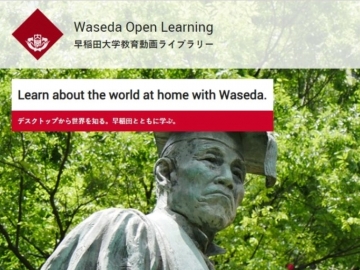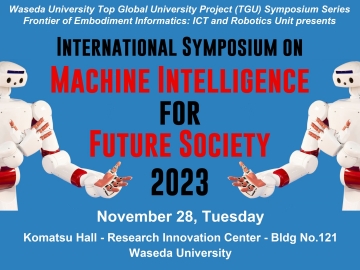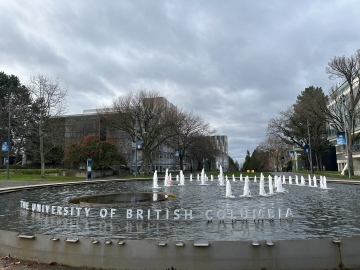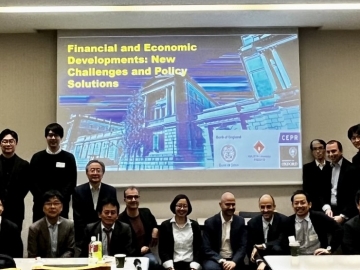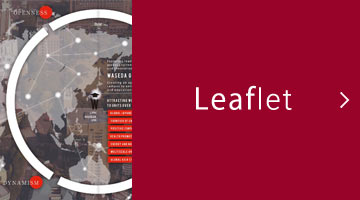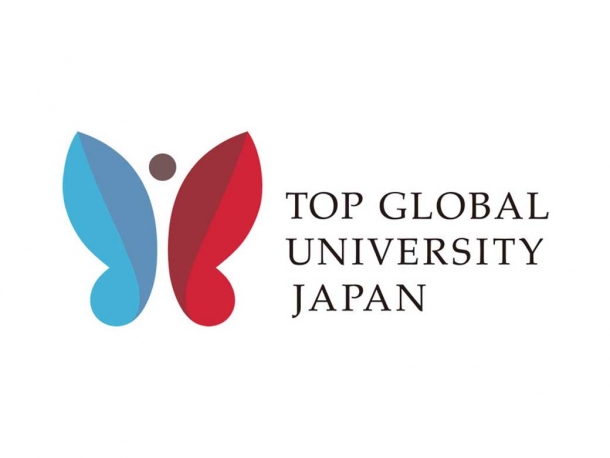On October 26, 2023, researchers who have interacted with the Energy and Nanomaterials Unit through the past 10 years of activities gathered to report the results of a variety of international collaborative activities and research activities, as well as to exchange opinions from various perspectives, with an eye toward further collaboration in the future. In particular, the symposium was held with the purpose of proposing and discussing ideas, based on each individual’s knowledge, toward the realization of a carbon-neutral society, an initiative of Waseda University.
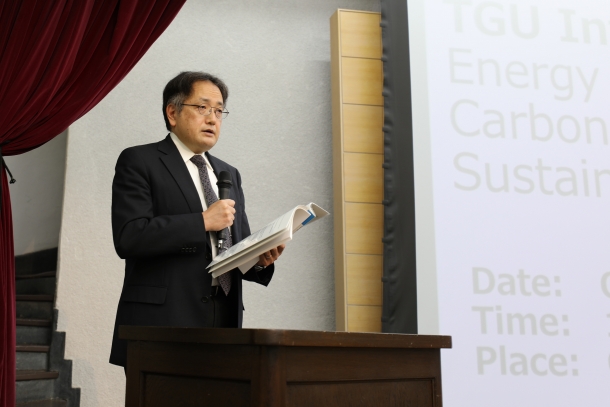 First, Unit Leader Kenichi Oyaizu opened the symposium by explaining its purpose and briefly introducing each speaker and their relationship to the Energy and Nanomaterials Unit.
First, Unit Leader Kenichi Oyaizu opened the symposium by explaining its purpose and briefly introducing each speaker and their relationship to the Energy and Nanomaterials Unit.
Lecture 1 “The Energy & Nanomaterials Unit of the TGU Program – Our Decade and Beyond –”
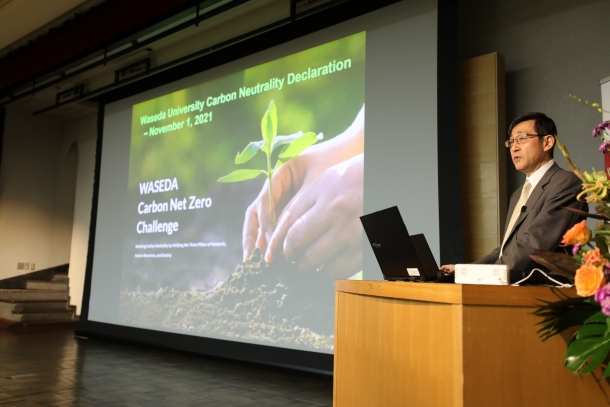 Professor Takayuki Homma, Executive Vice President and Vice Provost of Waseda University, gave an overview of the Top Global University Project and the Energy and Nanomaterials Unit, and reported on the progress of their activities over the past 10 years as a former Unit Leader. He also introduced ongoing projects such as the Waseda Carbon Net Zero Challenge 2030s and the Waseda Center for a Carbon Neutral Society, which the University is working on through research and education.
Professor Takayuki Homma, Executive Vice President and Vice Provost of Waseda University, gave an overview of the Top Global University Project and the Energy and Nanomaterials Unit, and reported on the progress of their activities over the past 10 years as a former Unit Leader. He also introduced ongoing projects such as the Waseda Carbon Net Zero Challenge 2030s and the Waseda Center for a Carbon Neutral Society, which the University is working on through research and education.
Lecture 2 “Carbon Economy: Advances in Materials and Energy Research”
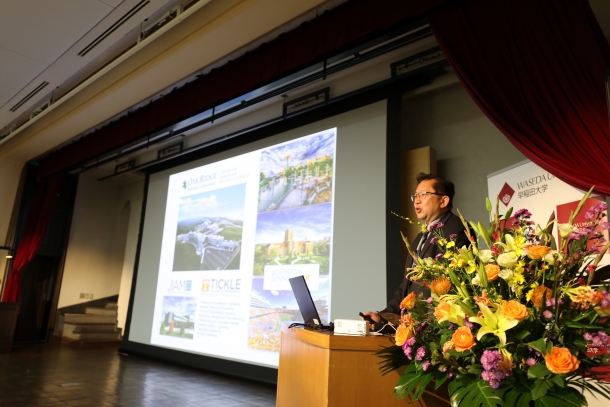
Professor Rigoberto C. Advincula of the University of Tennessee, Knoxville, gave a lecture on the title topic. Professor Advincula is a group leader at Oak Ridge National Laboratory (ORNL), which is part of the U.S. Department of Energy (DOE). He was also a JA (Joint Appointment) faculty member at Waseda University in 2017 and engaged in educational and research activities. In the lecture, he introduced the DOE and ORNL, providing an overview of ORNL’s efforts in DOE energy policy and technology strategy. They are promoting research in line with the guidelines for the hydrogen economy and ammonia economy, which were introduced by the DOE Energy Earthshots Initiative in an effort to reduce energy consumption, directly capture carbon, and achieve net-zero neutral carbon. This includes initiatives such as “Hydrogen Shot”, “Long Duration Storage Shot”, “Carbon Negative Shot”, “Enhanced Geothermal Shot”, “Floating Offshore Wind Shot”, “Industrial Heat Shot”, and “Clean Fuels & Products Shot”. Specific examples presented by ORNL included countermeasures for the enormous plastic waste problem (recycling or upcycling, oil or bioresources), perspectives on manufacturing technology that adds value by resource conservation and reduction of environmental impact through 3D printing, and smart material development that incorporates AI and robotic synthesis. Additionally, projects between ORNL and the University of Tennessee that have started to receive large amounts of funding from the U.S. Office of Scientific and Technical Information (OSTI) and the Office of Energy Efficiency and Renewable Energy (EERE) were introduced alongside the research landscape, with calls for participation from Waseda University. After the lecture, a question-and-answer session was held that focused on the indicators and procedures for evaluating sustainability, or so-called “greenness”.
Lecture 3 “Physical Electrochemistry Research in the United States: Energy-Related Technologies for a Carbon Neutral Future”
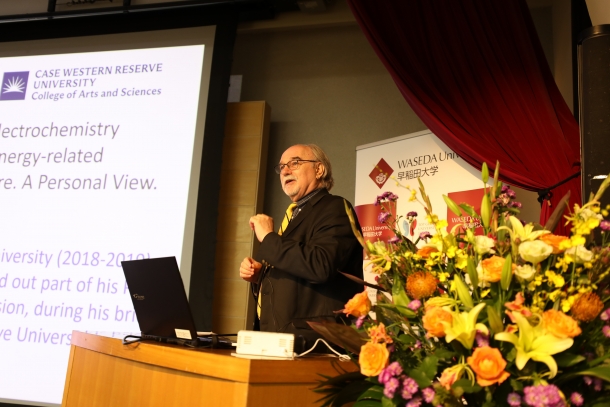 Professor Daniel A. Scherson of Case Western Reserve University in the United States presented this lecture. Professor Scherson was engaged in research and education activities at Waseda University in 2018 as a JA faculty member of the Unit.
Professor Daniel A. Scherson of Case Western Reserve University in the United States presented this lecture. Professor Scherson was engaged in research and education activities at Waseda University in 2018 as a JA faculty member of the Unit.
In this lecture, he introduced the National Blueprint for Lithium Batteries project that was designed and led by the Federal Consortium for Advanced Batteries (FCAB) under the U.S. Department of Energy. This project aims to create, by 2030, a sustainable battery material and technology supply chain that supports long-term U.S. economic competitiveness and job creation, enables decarbonization, and meets national security requirements. He not only presented several examples of new anode and cathode materials being developed for lithium batteries but also touched upon STEM education and support for young researchers, emphasizing that the development of next-generation batteries is the biggest challenge in science and technology. Finally, as a successful example of the Waseda University TGU project, he introduced the research results of a doctoral student from Waseda University he co-supervised with Professor Homma. A question-and-answer session was held to discuss the electrochemical methods used in the above-mentioned joint research and the position of fuel-cell development in the United States.
Lecture 4 “European Trends and Cooperation with Japan in the Development of Energy and Materials for Carbon Neutrality ~A Personal Perspective~”
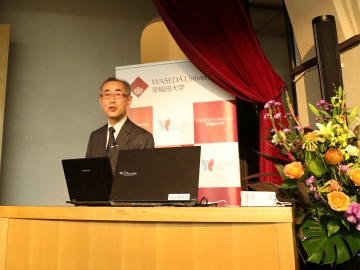 The Japan Society for the Promotion of Science (JSPS) Stockholm Office Director Kazuyuki Kuroda (Professor Emeritus at Waseda University) gave a lecture on the title topic. Professor Kuroda is also a former member of the Unit.
The Japan Society for the Promotion of Science (JSPS) Stockholm Office Director Kazuyuki Kuroda (Professor Emeritus at Waseda University) gave a lecture on the title topic. Professor Kuroda is also a former member of the Unit.
In this lecture, he compared and positioned the scientific, industrial, and innovative capabilities of Japan, the United States, China, and South Korea, and their roles in the EU, with a focus on projects initiated by the EU. He also relayed the latest information based on various sources, with the theme of energy and materials development toward carbon neutrality in the EU, and carbon neutrality initiatives and international cooperation at European universities toward the realization of a sustainable society. In particular, he provided an overview of the scale and structure of the Horizon Europe project, target items, and their selection and evaluation procedures. In this overview, he described the current situation, in which advanced materials are seen as the most important aspect to creating new energy and environmental technologies. Professor Kuroda also mentioned Stockholm University’s carbon neutrality roadmap, which could serve as a model for Japanese universities, and the participation of around 18 countries outside the EU in the Horizon Europe project. He introduced the JSPS International Joint Research Program, which accelerates global collaborative research, and encouraged participants to utilize it. Questions were asked about Horizon Europe’s distinction, support, and bridging between university research and industry– academia collaboration stages, and opinions were exchanged.
Lecture 5 “Towards net-zero carbon economy in Scandinavia”
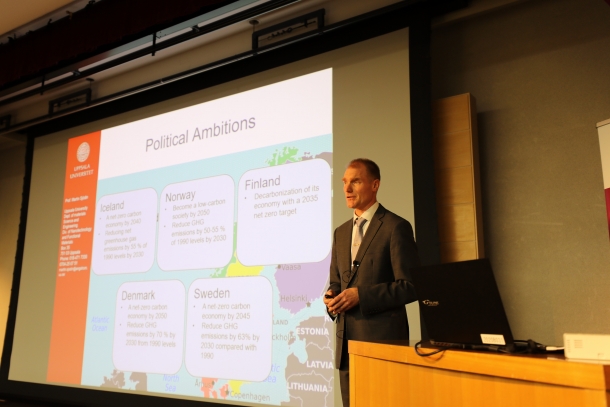 Professor Martin Sjödin of Uppsala University lectured on this topic. Professor Sjödin was in residence at Waseda University in 2018 as a JA faculty member of the Unit and engaged in educational and research activities. Additionally, as a co-supervisor for the Joint Supervision Program, he accepted doctoral students from Waseda University to Uppsala University and supervised their research.
Professor Martin Sjödin of Uppsala University lectured on this topic. Professor Sjödin was in residence at Waseda University in 2018 as a JA faculty member of the Unit and engaged in educational and research activities. Additionally, as a co-supervisor for the Joint Supervision Program, he accepted doctoral students from Waseda University to Uppsala University and supervised their research.
Under the 2015 Paris Agreement, the Scandinavian countries of Iceland, Norway, Denmark, Sweden, and Finland aimed to limit the rise in global average temperatures to no more than 2 °C (target of 1.5 °C) above pre-industrial levels. These countries are at the forefront of the transformation to a fossil fuel-free society, pledging to become a carbon net-zero economy by 2050 at the latest. The five countries have laid out a mutually complementary roadmap toward a common goal based on their historical, geological, and geographical conditions. Each country’s strategy was outlined, while key achievements and progress toward a sustainable society were illustrated, such as deep geothermal power generation, carbon capture and storage, green shipping, offshore wind power, fossil fuel-free steel, and battery recycling. Questions were asked about the environmental protection associated with exploration, refining, and facility installation in energy resource development. The response was that Northern Europe was learning from its negative history of over-logging and wastewater in the thermal pulp industry.
Lecture 6 “Sustainable Materials and Ecosystems Research in Germany for a Carbon Neutral Society”
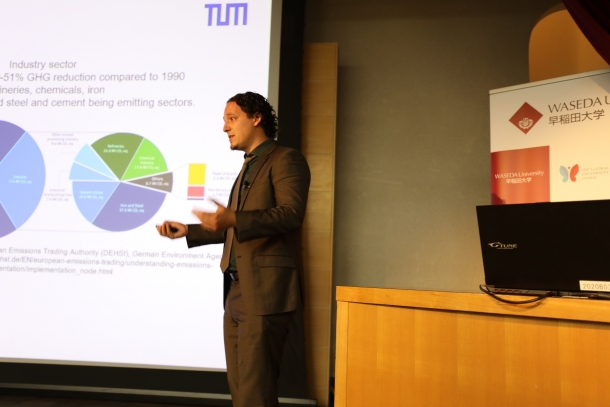 Professor Rubén D. Costa of the Technical University of Munich (TUM) delivered a lecture on this topic. Professor Costa resided at Waseda University in 2018 and 2019 as a visiting faculty member and JA associate professor and was engaged in educational and research activities. He supervised doctoral students and co-authored five papers.
Professor Rubén D. Costa of the Technical University of Munich (TUM) delivered a lecture on this topic. Professor Costa resided at Waseda University in 2018 and 2019 as a visiting faculty member and JA associate professor and was engaged in educational and research activities. He supervised doctoral students and co-authored five papers.
In the lecture, he first introduced Germany’s Net-Zero CO2 Mission, a policy aimed at reducing greenhouse gas emissions in industry. Professor Costa also introduced the current state of bioeconomy research in Germany, particularly the efforts of TUM. The university launched the Sustainable Futures Strategy 2030 and is focusing on shaping a sustainable future from an early stage through strategic research initiatives. One example is the TUM Campus Straubing for Biotechnology and Sustainability, where Professor Costa is the Vice Dean of Research and Innovation. The institution conducts integrated research and education on renewable resources, biotechnology, and bioeconomy. He provided an overview of the most relevant research and industrial activities and their impact. Finally, he touched upon the achievements of the past four TGU joint workshops through mutual visits and the relationships of trust that have stemmed from them, as well as the progress made in inter-facility agreements with TUM. During the question-and-answer session, he introduced how the university was not only strongly collaborating and contributing to local industries and city government but also working to support startups and developing job opportunities for students.
Lecture 7 “Trends and Policies on Carbon Neutral Research in Japan”
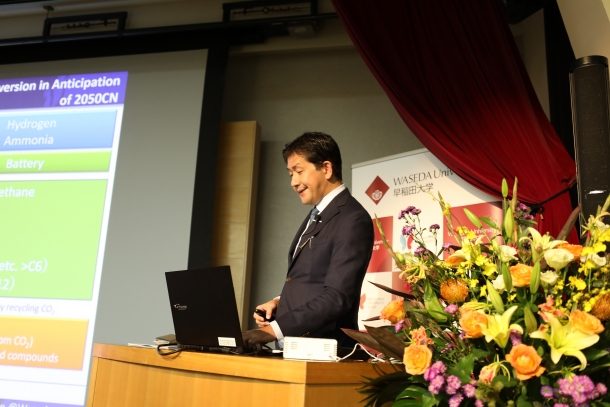 Professor Yasushi Sekine of the Waseda University Faculty of Science and Engineering gave a lecture on this topic. Professor Sekine is the Director of the Center for Research Strategy at Waseda University, a top-level principal investigator at the Waseda Center for a Carbon Neutral Society, and an active member of the Energy and Nanomaterials Unit. He has been involved in formulating Japan’s energy technology strategy as a member of the Green Innovation Project Subcommittee of the Industrial Structure Council (Ministry of Economy, Trade and Industry). He is also a member and working group chairman of the Green Innovation Strategy Promotion Council (Cabinet Office, etc.) and a member of the Government Clean Energy Strategy Committee, among others.
Professor Yasushi Sekine of the Waseda University Faculty of Science and Engineering gave a lecture on this topic. Professor Sekine is the Director of the Center for Research Strategy at Waseda University, a top-level principal investigator at the Waseda Center for a Carbon Neutral Society, and an active member of the Energy and Nanomaterials Unit. He has been involved in formulating Japan’s energy technology strategy as a member of the Green Innovation Project Subcommittee of the Industrial Structure Council (Ministry of Economy, Trade and Industry). He is also a member and working group chairman of the Green Innovation Strategy Promotion Council (Cabinet Office, etc.) and a member of the Government Clean Energy Strategy Committee, among others.
In line with his lecture topic, he presented Japan’s green innovation policy toward carbon neutrality in 2050. Moving away from fossil fuels is urgent in order to solve global environmental problems and achieve carbon neutrality. Looking at Japan’s primary energy consumption structure, a quarter of the calorific value comes from natural gas and coal, slightly less than half is derived from oil, and the rest comes from domestic renewable energy. Promoting carbon-neutral green transformation (GX) in the future requires the utilization of resources that exist everywhere on Earth’s surface (water, carbon dioxide, biomass such as plant resources, and waste) based on solar energy, with the expectation of producing chemicals and fuel as a result. These renewable energies need to supplement city gas, thermal power generation, petrochemical raw materials, and fuel for large vehicles and aviation. The production of synthetic hydrocarbons using carbon dioxide or biomethane recovered from exhaust gas as the main carbon source will be extremely important. Water electrolysis-based hydrogen from renewable energy, biomass reformation, and electrolytic synthesis using water directly as a proton source are also expected to serve as hydrogen sources. At the same time, the expectations for negative emission technologies that reduce the concentration of carbon dioxide in the atmosphere are high. Professor Sekine mentioned that taking on the challenge of these technologies will be difficult and costly, but those who have access to sustainable technologies will be winners in the future. He indicated that the utilization of energy and material in the right places is important for Japan, which has low potential in renewable resources and faces various risks. He emphasized that Japan needs to assess the essence of thermodynamics from a long-term perspective and repeat research and development without clinging to “stranded assets” just because they are costly.
Lecture 8 “Carbon Pricing for Carbon Neutrality in Japan”
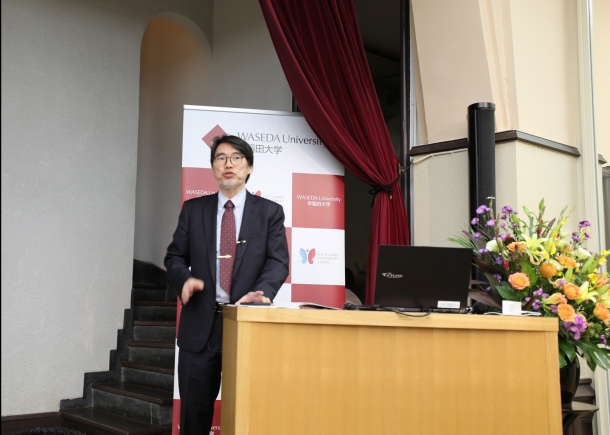 Professor Toshihide Arimura of the Waseda University Faculty of Political Science and Economics spoke about this topic. Professor Arimura serves on numerous committees of government ministries and agencies related to environmental issues, including the Central Environmental Council (Subcommittee on the Utilization of Carbon Pricing) of the Ministry of the Environment of Japan.
Professor Toshihide Arimura of the Waseda University Faculty of Political Science and Economics spoke about this topic. Professor Arimura serves on numerous committees of government ministries and agencies related to environmental issues, including the Central Environmental Council (Subcommittee on the Utilization of Carbon Pricing) of the Ministry of the Environment of Japan.
Japan is working on measures to prevent global warming, but its carbon pricing policy, which adds CO2 emissions to prices and reflects environmental issues in the market, lags behind Europe. He first outlined the history of carbon pricing in Japan and the newly introduced emissions trading system (GX-ETS). Japan has introduced a low carbon tax of 289 yen per ton, with an emissions trading system started in Tokyo in 2010 and in Saitama Prefecture in 2011. In line with the GX Promotion Act enacted this year, carbon pricing has spread, and a carbon credit market has been launched across the country. Professor Arimura’s team introduced an ex-post evaluation of the emissions trading system in Tokyo and Saitama Prefecture, particularly the achievements of adopting energy-conserving technologies in office buildings and manufacturing industries, and the contribution of ETS after subtracting other factors such as rising electricity costs. Furthermore, he talked about the expectations of the establishment of the GX Fund and the operation of bonds that will stimulate renewable energy and new energy-conserving technologies, the carbon surcharge that will be implemented in 2028, and the ETS permit auction that will be held in 2033. He also introduced the importance of “double dividends from carbon taxes” as a perspective on carbon taxes.
Lecture 9 “Circular Economy and Materials for a Carbon Neutral Future”
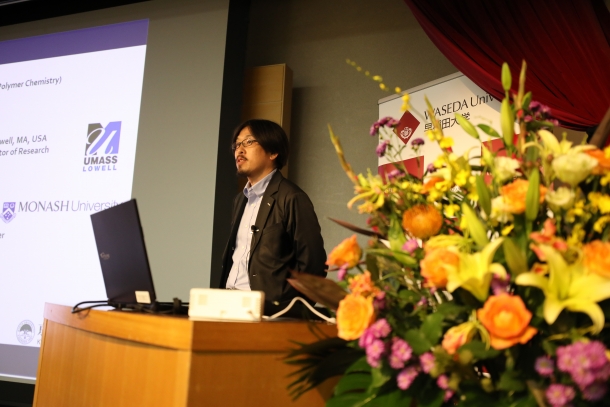 Professor Kei Saito of the Kyoto University Graduate School of Advanced Integrated Studies in Human Survivability (Shishukan) gave this lecture. Professor Saito was instrumental in concluding the Joint Supervision Program agreement when he was a faculty member at Monash University in Australia. Through this program, he accepted three doctoral students, who graduated through joint supervision. He was also engaged in educational and research activities at Waseda University in 2020 as a visiting faculty member.
Professor Kei Saito of the Kyoto University Graduate School of Advanced Integrated Studies in Human Survivability (Shishukan) gave this lecture. Professor Saito was instrumental in concluding the Joint Supervision Program agreement when he was a faculty member at Monash University in Australia. Through this program, he accepted three doctoral students, who graduated through joint supervision. He was also engaged in educational and research activities at Waseda University in 2020 as a visiting faculty member.
First, Professor Saito introduced Shishukan, where he is currently located. Shishkukan is an independent graduate school that aims to provide doctoral education with comprehensive knowledge in interdisciplinary fields, including politics, economics, social studies, humanities, science, technology, and informatics. He also talked about a series of research topics under development.
New materials for a carbon-neutral future need to be designed to fit into a world of circular economy. Professor Saito is particularly focused on the future of plastics, with the aims of implementing green chemistry principles in the field of manufacturing, including life cycle assessment, and creating circular economy for materials. For example, he has great interest in reusable and recyclable dynamic polymers in which atoms are connected by dynamic (reversible) covalent and non-covalent bonds, and he presented dynamically bonded plastics as self-healing materials whose bonds could be broken by heat or light and easily return to the raw material. He also mentioned future issues such as cost assessments, revisions of laws and regulations, and the utilization of AI.
Summary: “Summary address for TGU International Symposium”
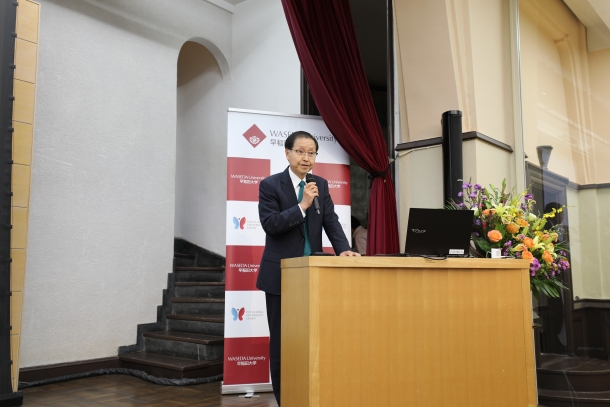 Dr. Jinichi Igarashi (advisor for ENEOS Research Institute, Ltd., former director of ENEOS Corporation Central Technical Research Laboratory) is the managing director and chairman of the working committee, Council on Competitiveness-Nippon (COCN). He spoke on behalf of industry.
Dr. Jinichi Igarashi (advisor for ENEOS Research Institute, Ltd., former director of ENEOS Corporation Central Technical Research Laboratory) is the managing director and chairman of the working committee, Council on Competitiveness-Nippon (COCN). He spoke on behalf of industry.
The COCN is a voluntary organization that was established in 2006 by business leaders from various fields in the private sector and has a close cooperative relationship with the Japan Business Federation. The chairman of the board is Nobuhiro Endo, a special advisor to the NEC Corporation (NEC). Their aim is to propose and implement policies that strengthen Japan’s industrial competitiveness; promote science, technology, and innovation; and sustainably develop Japan through close collaboration and productive discussions between industry, academia, and the public and private sectors. Energy problems are an important global issue for the realization of a carbon-neutral society in a sustainable future, but the circumstances surrounding new energy policies differ depending on the region. Japan, which geographically and geopolitically differs from other regions, must learn from other regions, collaborate with other regions, and strive for global harmony while aiming to solve problems in its own direction. The hope is that this initiative led by Waseda University, which has a global academic network, will serve as a role model for future directions that will strengthen its competitiveness. Although we are confident in our success as a Unit in science and technology, the transition to a carbon-neutral society requires not only technological innovation but also changes in policy, industrial practices, and individual behavior. COCN hopes to promote such changes in cooperation with academia, related organizations, and governments. Dr. Igarashi called for connecting the knowledge, insights, and networks cultivated at this symposium to the future, and to move forward together toward the realization of a carbon-neutral society for a sustainable future.
Next, young researchers involved in educational and research activities at the Energy & Nanomaterials Unit shared their experiences.
Lecture 1 “Australia to Waseda to Europe: Experiences and Impact on Research”
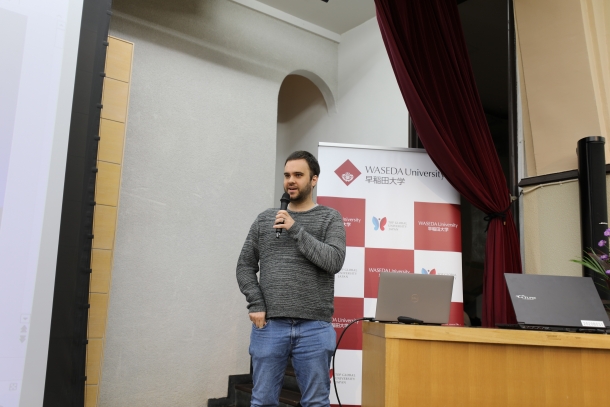
Dr. Luke Wylie of the University of Bonn (Germany) gave a lecture. Dr. Wylie participated in the Joint Supervision Program when he was a student at Monash University, and from 2018 to 2019, he resided at Waseda University, where he was jointly supervised. By sharing how his experience at Waseda University and living in a different culture gave him great confidence in leaving his home country and accepting a research position in France and Germany after obtaining his degree, he motivated students and young researchers in particular. He also stressed the valuable knowledge and experience he gained through research collaboration.
Lecture 2 “In-situ Spectroscopic Measurements and Computational Analyses in TGU Activities”
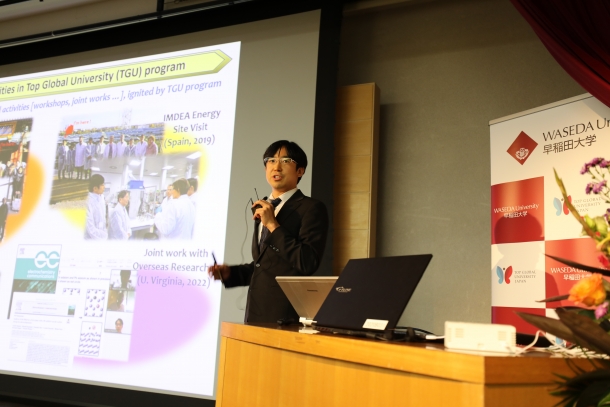
Associate Professor Masahiro Kunimoto of the Waseda University Faculty of Science and Engineering shared his experiences participating in joint research with JA faculty members and his discussions with overseas universities. He described how, as his own research field expanded through joint research, his original research method became centered on a Raman spectral in-situ analysis method, which has been refined through joint research with overseas partner institutions. He also touched upon his experience with overseas universities; he was impressed by their positive attitudes and desire to yield productive results. Professor Kunimoto also emphasized the need to incorporate informatics as early as possible.
This symposium has held to showcase the achievements of the Energy and Nanomaterials Unit under the University’s Waseda Goes Global Plan, an initiative funded by the Japanese Ministry of Education, Culture, Sports, Science and Technology (MEXT) Top Global University Project.
